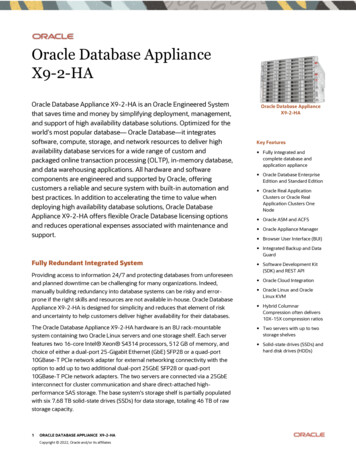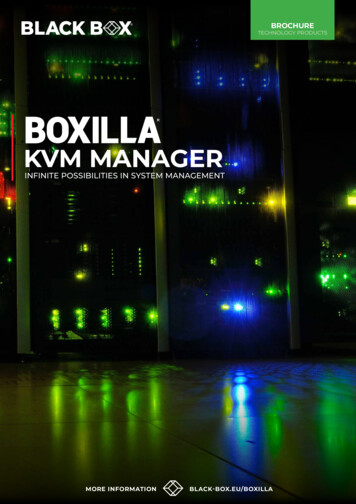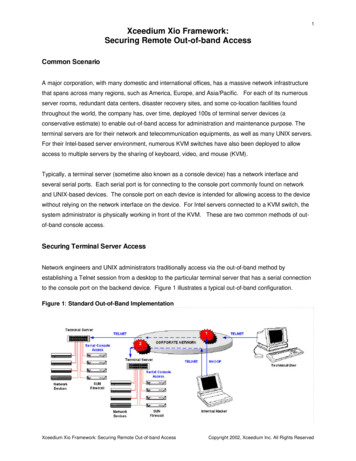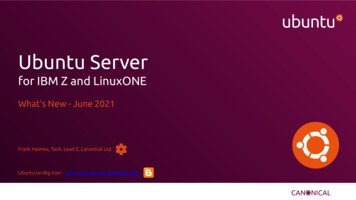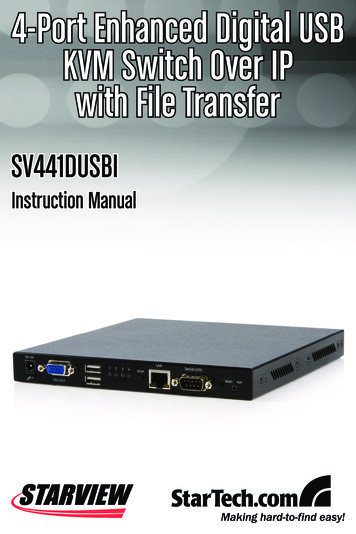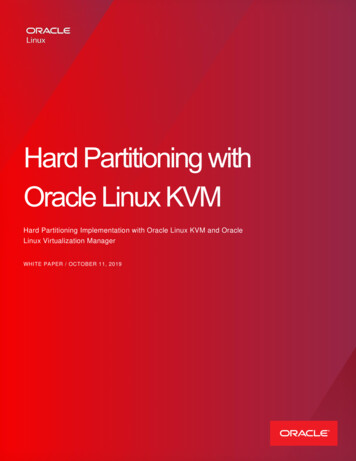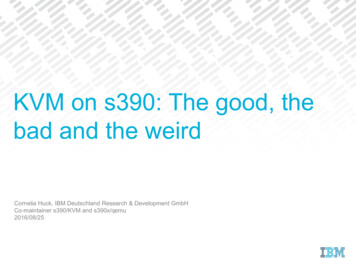
Transcription
KVM on s390: The good, thebad and the weirdCornelia Huck, IBM Deutschland Research & Development GmbHCo-maintainer s390/KVM and s390x/qemu2016/08/25
TrademarksThe following are trademarks of the International Business Machines Corporation in the United States and/or other ocketsIBM*Ibm.comIBM (logo)*IMSInformix*InfoSphereLinuxONELinuxONE EmperorLinuxONE um Scale*SPSS*Storwize*System 13z13szEnterprise*z/OS*z Systemsz/VSE*z/VM** Registered trademarks of IBM CorporationThe following are trademarks or registered trademarks of other companies.Adobe, the Adobe logo, PostScript, and the PostScript logo are either registered trademarks or trademarks of Adobe Systems Incorporated in the United States, and/or other countries.IT Infrastructure Library is a registered trademark of the Central Computer and Telecommunications Agency which is now part of the Office of Government Commerce.Intel, Intel logo, Intel Inside, Intel Inside logo, Intel Centrino, Intel Centrino logo, Celeron, Intel Xeon, Intel SpeedStep, Itanium, and Pentium are trademarks or registered trademarks of IntelCorporation or its subsidiaries in the United States and other countries.Linux is a registered trademark of Linus Torvalds in the United States, other countries, or both.Microsoft, Windows, Windows NT, and the Windows logo are trademarks of Microsoft Corporation in the United States, other countries, or both.Windows Server and the Windows logo are trademarks of the Microsoft group of countries.ITIL is a registered trademark, and a registered community trademark of the Office of Government Commerce, and is registered in the U.S. Patent and Trademark Office.UNIX is a registered trademark of The Open Group in the United States and other countries.Java and all Java based trademarks and logos are trademarks or registered trademarks of Oracle and/or its affiliates.Cell Broadband Engine is a trademark of Sony Computer Entertainment, Inc. in the United States, other countries, or both and is used under license therefrom.Linear Tape-Open, LTO, the LTO Logo, Ultrium, and the Ultrium logo are trademarks of HP, IBM Corp. and Quantum in the U.S. and other countries.* Other product and service names might be trademarks of IBM or other companies.Notes:Performance is in Internal Throughput Rate (ITR) ratio based on measurements and projections using standard IBM benchmarks in a controlled environment. The actual throughput that any user will experience will varydepending upon considerations such as the amount of multiprogramming in the user's job stream, the I/O configuration, the storage configuration, and the workload processed. Therefore, no assurance can be given that anindividual user will achieve throughput improvements equivalent to the performance ratios stated here.IBM hardware products are manufactured from new parts, or new and serviceable used parts. Regardless, our warranty terms apply.All customer examples cited or described in this presentation are presented as illustrations of the manner in which some customers have used IBM products and the results they may have achieved. Actual environmentalcosts and performance characteristics will vary depending on individual customer configurations and conditions.This publication was produced in the United States. IBM may not offer the products, services or features discussed in this document in other countries, and the information may be subject to change without notice. Consultyour local IBM business contact for information on the product or services available in your area.All statements regarding IBM's future direction and intent are subject to change or withdrawal without notice, and represent goals and objectives only.Information about non-IBM products is obtained from the manufacturers of those products or their published announcements. IBM has not tested those products and cannot confirm the performance, compatibility, or any otherclaims related to non-IBM products. Questions on the capabilities of non-IBM products should be addressed to the suppliers of those products.Prices subject to change without notice. Contact your IBM representative or Business Partner for the most current pricing in your geography.This information provides only general descriptions of the types and portions of workloads that are eligible for execution on Specialty Engines (e.g, zIIPs, zAAPs, and IFLs) ("SEs"). IBM authorizes customers to use IBM SEonly to execute the processing of Eligible Workloads of specific Programs expressly authorized by IBM as specified in the “Authorized Use Table for IBM Machines” provided atwww.ibm.com/systems/support/machine warranties/machine code/aut.html (“AUT”). No other workload processing is authorized for execution on an SE. IBM offers SE at a lower price than General Processors/CentralProcessors because customers are authorized to use SEs only to process certain types and/or amounts of workloads as specified by IBM in the AUT.
What's this about?
What's this about? s390 (aka z Systems ) was the second architecture to implementKVMFirst with a custom userspace (kuli), then with qemuKVM on s390 exploits some neat architecture features.but also had to deal with some decisions that sounded good atthe time.and some rather odd things that are different from everybodyelse
Let's get startedSIE – Start Interpretive Execution
Let's get started SIE uses per-vcpu control blocks in host memory .this is nice for nested virtualizationSatellite control blocks for some assistsIntercept controls to enable manual interpretationCool feature: ibc to fence back to a previous machine generationIntercept requests to get a vcpu out of the SIE Headscratcher: We can request exit for stop, I/O and external –but not for machine checksVarious SIE exits: instruction, program interrupt, idle.but mostly mapped to the same exit code in KVM
Let's get started (Nearly) everything used to be mapped to a single SIE exit reasonDrawbacks: we need to fetch state, as we don't know what weneed to handle the intercept Instruction intercepts, wait states or program checks all needdifferent statusNew 'specialist' exit codes (for handling of tsch, stsi, ).but a far cry from the variety of exit reasons on otherarchitectures
Channels and paths and programs
Channels and paths and programsvirtiodiagnose 500external interruptstschcc 3chsccc 3Guest memory
Channels and paths and programscssdiagnose 500I/O interruptsch 0sch 1virtio 0virtio 1stschGuest memorychscsschtsch.
Channels and paths and 12
Channels and paths and programs stsch, msch, tsch – deal with device descriptionsssch, rsch, hsch, csch, xsch – deal with channel programschsc – deal with a whole lot of thingsNeat features: All I/O instructions are mandatory intercepts Common set of architectural descriptions for all devices All I/O devices can describe themselves
Channels and paths and programs virtio – the easy case Fully virtual channel subsystem Channel paths do nothingPassthrough (vfio) and emulation is more complicated Need 'real' channel paths Some refactoring to accommodate non-virtio devices Vfio-ccw would be a talk in itself
It's PCI, but not as you know it PCI is a relative newcomer to the s390Only certain cards supported (RoCE, Flash, Compression)Needed to fit with existing paradigmsNo MMIO!Various instructions for reading/writing memoryIntegration into existing I/O infrastructure (adapter interrupts,channel-subsystem machine checks).and NO topology information!
It's PCI, but not as you know itYou wantYou useYou getAll PCI functions and theirconfigurationCLP List PCI Functions andCLP Query PCI FunctionList of functions with FH,FID, UID, BARs and DMAvalues – NObus/slot/function topology!Read/write PCI config spacePCI LOAD and PCI STOREAccess to the config space –via privileged instructions!MSI interruptsAdapter interrupts andindicatorsMessage encoded withfunction index and indicatoroffsetHot(un)plug notificationsMachine-check notifiedeventsInformation extracted via achannel-subsystem call – butit is still PCI-specificinformation
It's PCI, but not as you know it Linux guest side integration worked quite well, but.host side modelling in qemu was not that easyChallenge: Reconcile qemu's topology-based modelling withzPCI's informationSolution: Build a 'fake' topology, add satellite zpci devices to stores390-specific information (fid, uid)
It's PCI, but not as you know itQuackQuack
The changing ways of SIGP
The changing ways of SIGP SIGP – Signal ProcessorFirst implementation: partly in the kernel, partly in userspace This did not play well with keeping cpu state in qemu. .and was racy between SIGPsMoved to userspace, guarded by a capability Privileged program exceptions still handled in the kernel Exception: 'fast' SIGPs which also need access to kernel state But we have to keep the old code around.Neat architecture feature: SIGP interpretation For a subset of SIGP calls, we can let the SIE handle it Exitless signalling of other vCPUs win
The call that wants to be a processor SCLP – service-call logical processorTakes on many tasks performed by a PC's BIOS/UEFI.but it is a well-specified interfaceIn practice, we emulate it as a simple call Send a control block (SCCB), get an (external) interrupt oncompletionSupported features vary with the machine generation
The call that wants to be a processor Provide information about the machine Number of cpus, amount of memory, .and a list of facilities that is not completely distinct from cpufacilitiesAllow to dynamically change the machine's current configuration Activate standby cpus, deactivate PCI functions, .Implement a console VT-220 compatible or line modeAll of this is best implemented in userspaceqemu models this as a device hierarchy
Let's talk about memoryG821
Let's talk about memory We need host kernel support to read/write memory in a correctwayReasons: IPTE lock (for DAT) To synchronize against page table changes by the SIE Contained in SIE control block Possible storage key operationsSolution: introduce an IOCTL (KVM S390 MEM OP)
Let's talk about memoryMEM OPaccess guestsrcu lock Get ACSEGet IPTE lockPerform DATsrcu unlock Release IPTE lockNote: Program checks may happen Key protection currently not implementedCheck arch/s390/kvm/gaccess.c for the gory detailskvm read guestkvm write guest
Thank you!
Cornelia Huck, IBM Deutschland Research & Development GmbH Co-maintainer s390/KVM and s390x/qemu 2016/08/25 KVM on s390: The good, the . LinuxONE LinuxONE Emperor LinuxONE Rockhopper Maximo* MQ* POWER* POWER*8* PR/SM RACF* Spectrum Scale* SPSS* Storwize* System z9* Systemz10* Tivoli* WebSphere* XIV* z/Architecture* z13 z13s zEnterprise*



